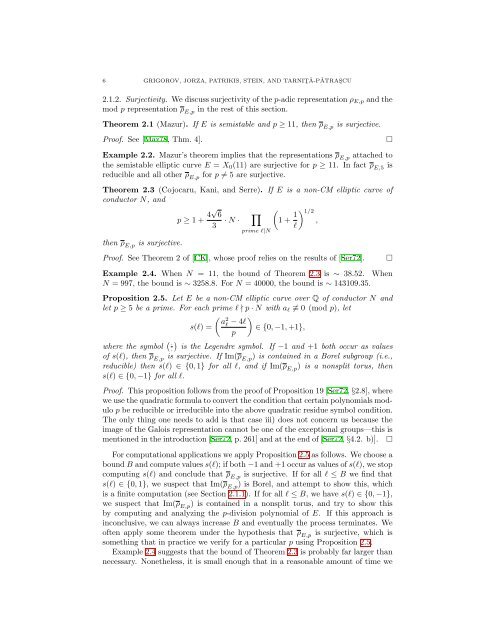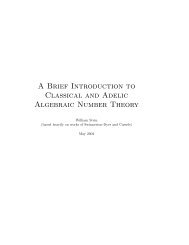COMPUTATIONAL VERIFICATION OF THE BIRCH ... - William Stein
COMPUTATIONAL VERIFICATION OF THE BIRCH ... - William Stein
COMPUTATIONAL VERIFICATION OF THE BIRCH ... - William Stein
Create successful ePaper yourself
Turn your PDF publications into a flip-book with our unique Google optimized e-Paper software.
6 GRIGOROV, JORZA, PATRIKIS, STEIN, AND TARNIT¸ Ǎ-PǍTRAS¸CU<br />
2.1.2. Surjectivity. We discuss surjectivity of the p-adic representation ρE,p and the<br />
mod p representation ρ E,p in the rest of this section.<br />
Theorem 2.1 (Mazur). If E is semistable and p ≥ 11, then ρ E,p is surjective.<br />
Proof. See [Maz78, Thm. 4]. <br />
Example 2.2. Mazur’s theorem implies that the representations ρ E,p attached to<br />
the semistable elliptic curve E = X0(11) are surjective for p ≥ 11. In fact ρ E,5 is<br />
reducible and all other ρ E,p for p = 5 are surjective.<br />
Theorem 2.3 (Cojocaru, Kani, and Serre). If E is a non-CM elliptic curve of<br />
conductor N, and<br />
p ≥ 1 + 4√6 · N ·<br />
3<br />
<br />
<br />
1 + 1<br />
1/2 ,<br />
ℓ<br />
then ρ E,p is surjective.<br />
prime ℓ|N<br />
Proof. See Theorem 2 of [CK], whose proof relies on the results of [Ser72]. <br />
Example 2.4. When N = 11, the bound of Theorem 2.3 is ∼ 38.52. When<br />
N = 997, the bound is ∼ 3258.8. For N = 40000, the bound is ∼ 143109.35.<br />
Proposition 2.5. Let E be a non-CM elliptic curve over Q of conductor N and<br />
let p ≥ 5 be a prime. For each prime ℓ ∤ p · N with aℓ ≡ 0 (mod p), let<br />
2 aℓ − 4ℓ<br />
s(ℓ) =<br />
∈ {0, −1, +1},<br />
p<br />
where the symbol <br />
· is the Legendre symbol. If −1 and +1 both occur as values<br />
·<br />
of s(ℓ), then ρE,p is surjective. If Im(ρE,p) is contained in a Borel subgroup (i.e.,<br />
reducible) then s(ℓ) ∈ {0, 1} for all ℓ, and if Im(ρE,p) is a nonsplit torus, then<br />
s(ℓ) ∈ {0, −1} for all ℓ.<br />
Proof. This proposition follows from the proof of Proposition 19 [Ser72, §2.8], where<br />
we use the quadratic formula to convert the condition that certain polynomials modulo<br />
p be reducible or irreducible into the above quadratic residue symbol condition.<br />
The only thing one needs to add is that case iii) does not concern us because the<br />
image of the Galois representation cannot be one of the exceptional groups—this is<br />
mentioned in the introduction [Ser72, p. 261] and at the end of [Ser72, §4.2. b)]. <br />
For computational applications we apply Proposition 2.5 as follows. We choose a<br />
bound B and compute values s(ℓ); if both −1 and +1 occur as values of s(ℓ), we stop<br />
computing s(ℓ) and conclude that ρ E,p is surjective. If for all ℓ ≤ B we find that<br />
s(ℓ) ∈ {0, 1}, we suspect that Im(ρ E,p) is Borel, and attempt to show this, which<br />
is a finite computation (see Section 2.1.1). If for all ℓ ≤ B, we have s(ℓ) ∈ {0, −1},<br />
we suspect that Im(ρ E,p) is contained in a nonsplit torus, and try to show this<br />
by computing and analyzing the p-division polynomial of E. If this approach is<br />
inconclusive, we can always increase B and eventually the process terminates. We<br />
often apply some theorem under the hypothesis that ρ E,p is surjective, which is<br />
something that in practice we verify for a particular p using Proposition 2.5.<br />
Example 2.4 suggests that the bound of Theorem 2.3 is probably far larger than<br />
necessary. Nonetheless, it is small enough that in a reasonable amount of time we
















